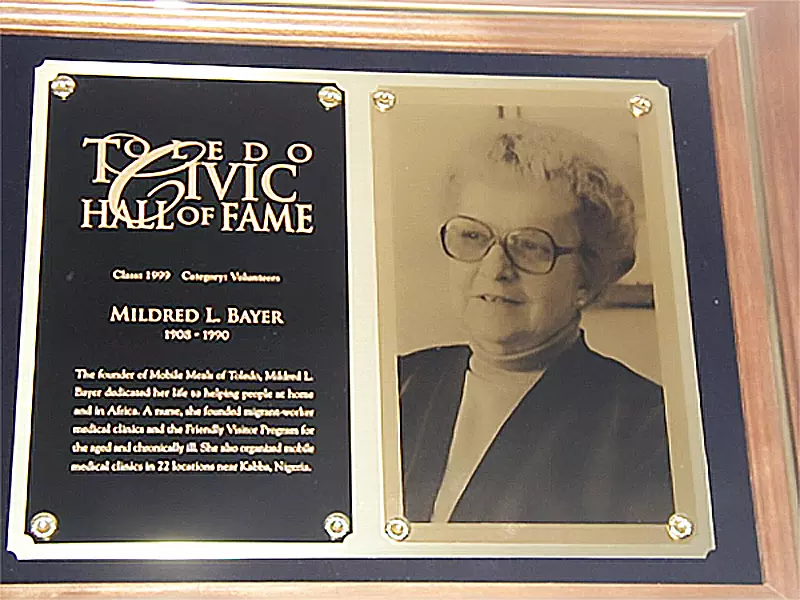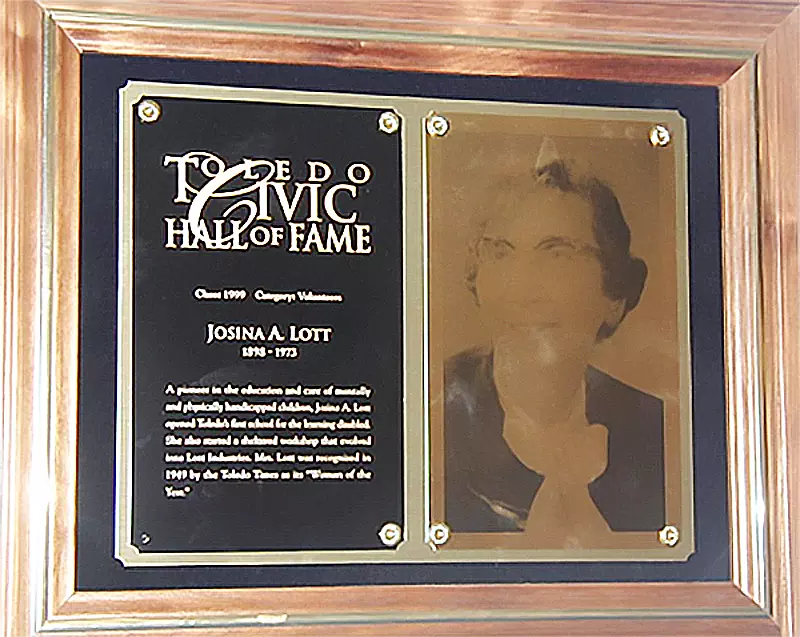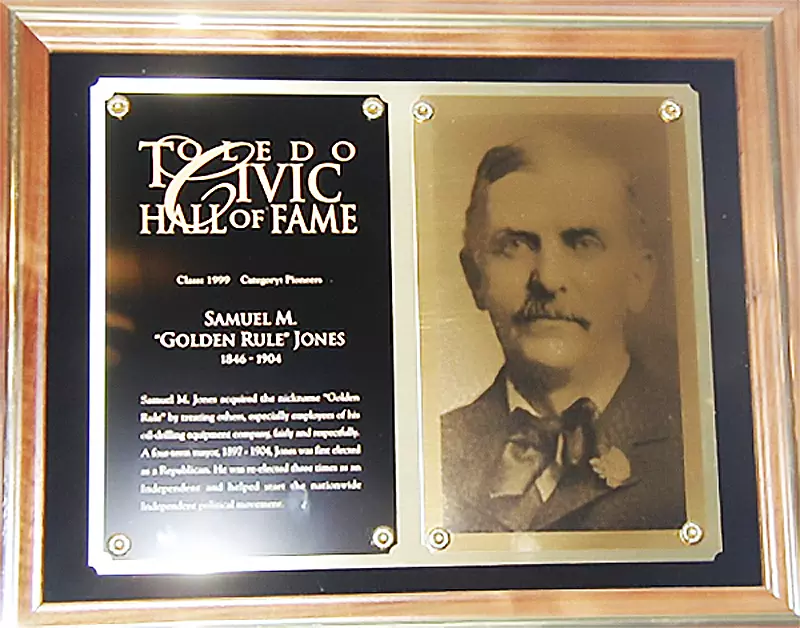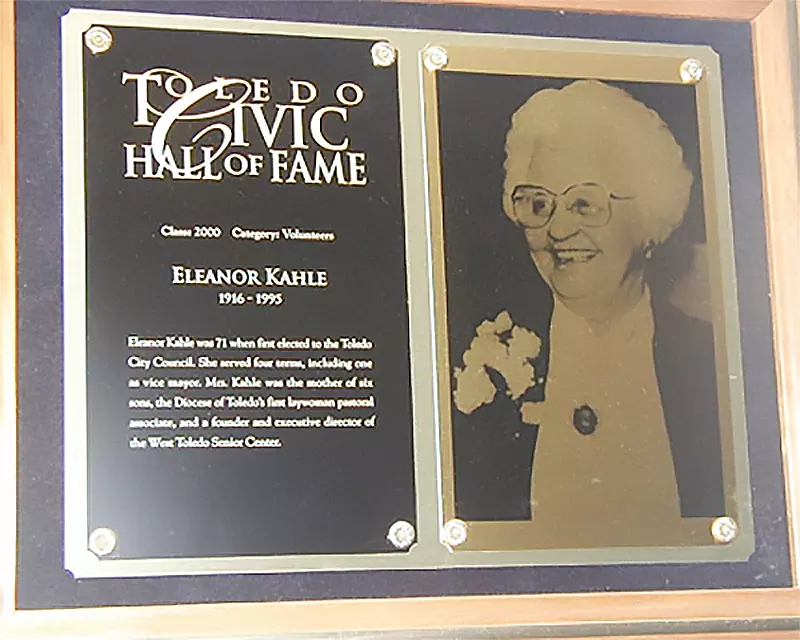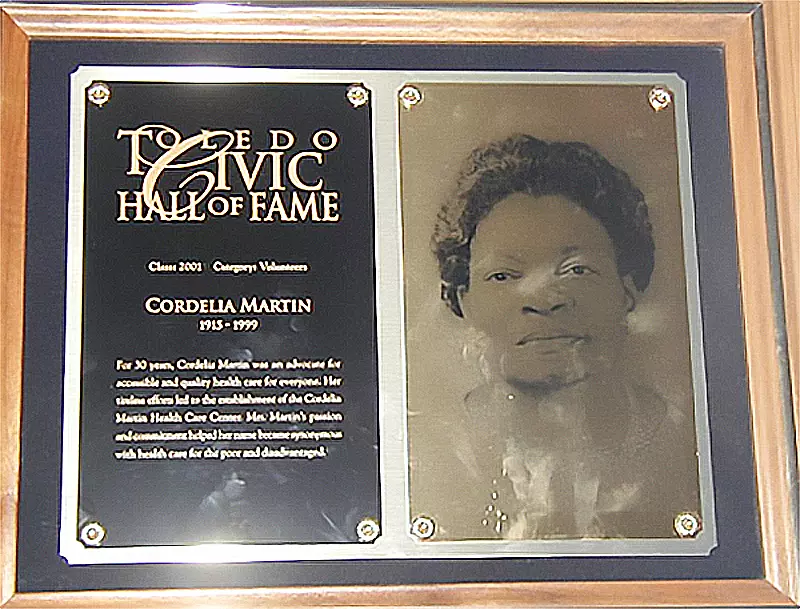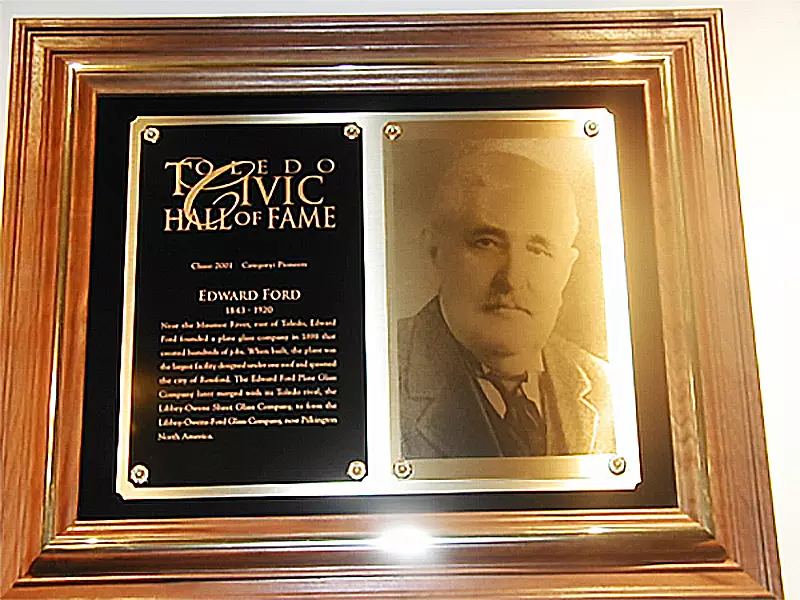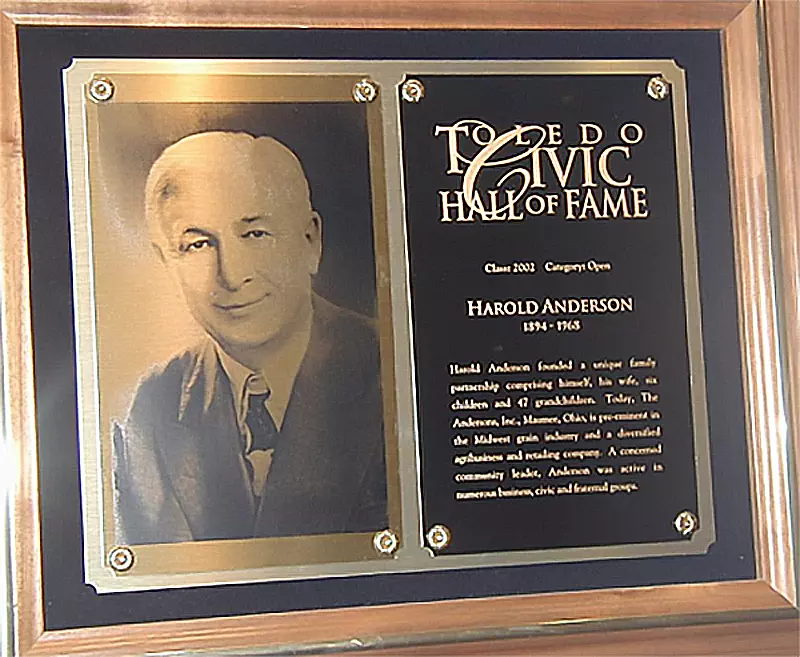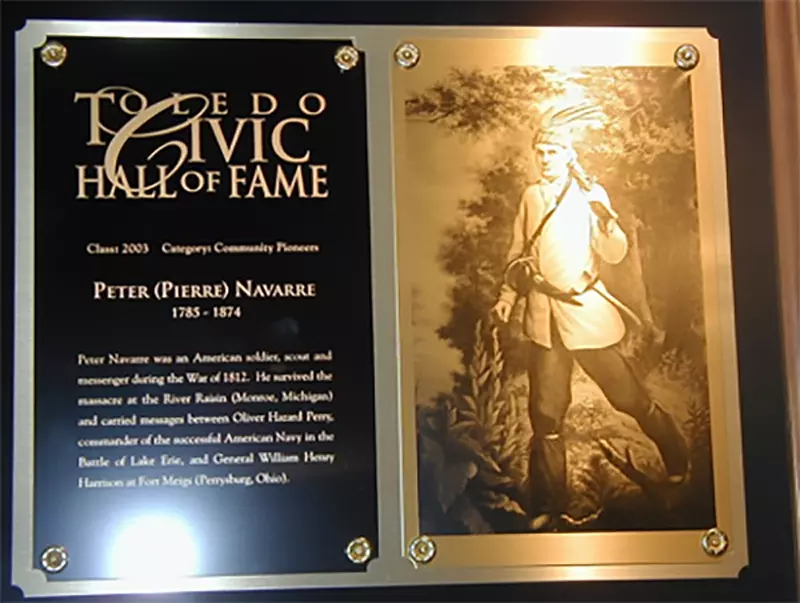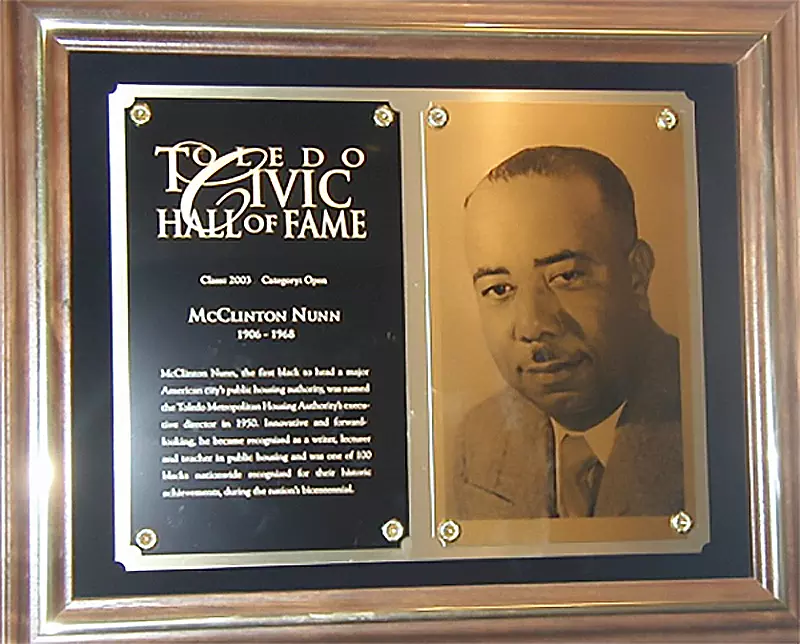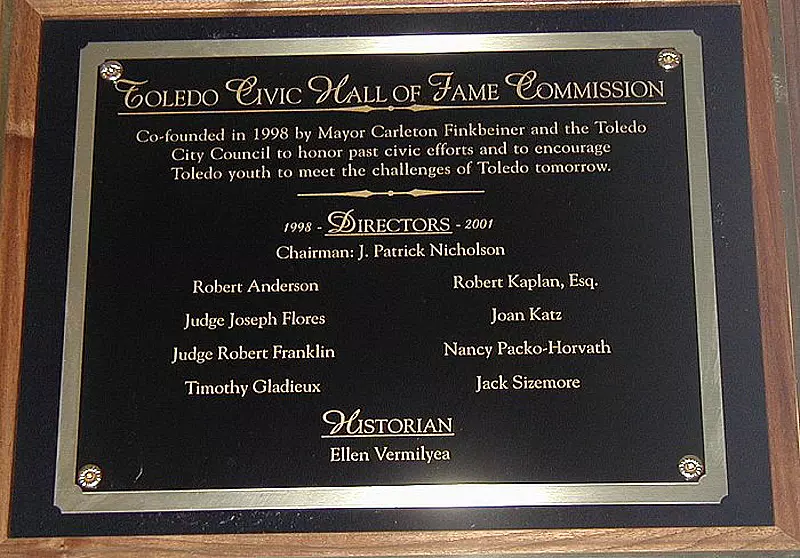 Toledo Civic Hall of Fame Commission
Toledo Civic Hall of Fame Commission
Exhibit Gallery
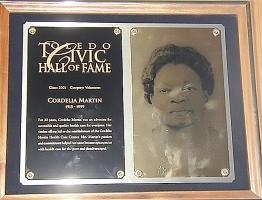
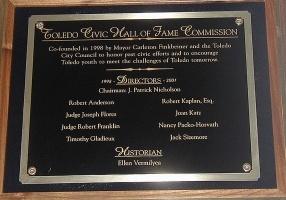
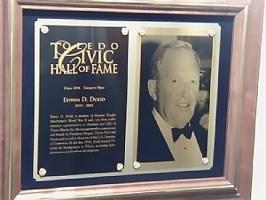
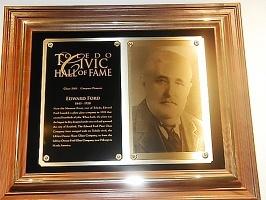
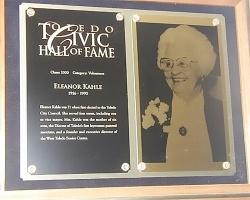
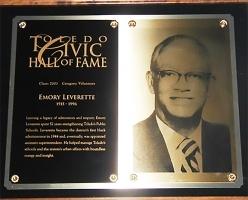
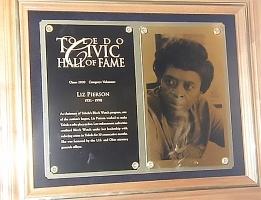
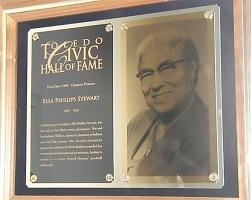
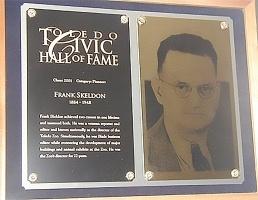
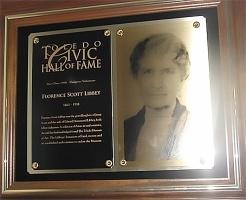
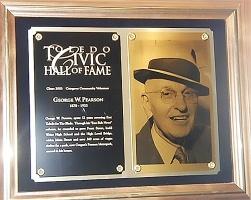
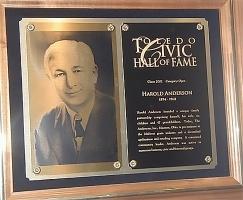
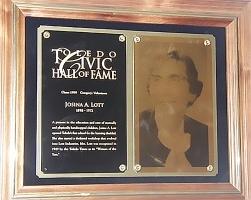
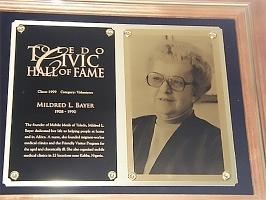
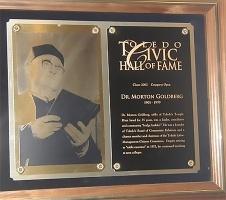
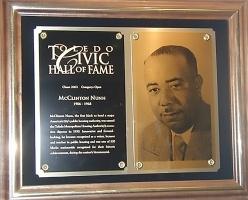
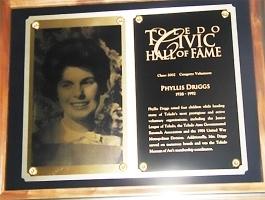
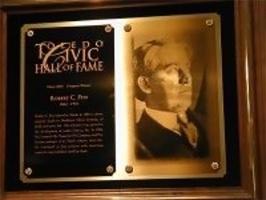
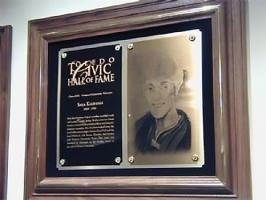
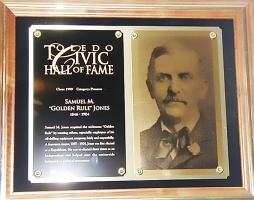
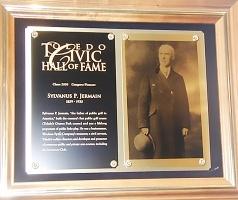
This exhibit is available in PDF format also. [PDF link]
Introduction
 Toledo Civic Hall of Fame Commission
Toledo Civic Hall of Fame Commission
Mayor Carty Finkbeiner began the Toledo Civic Hall of Fame in 1998. The Mayor appointed a nine-member commission to select four to eight people who had died at least two years prior and made major sustainable contributions to northwest Ohio outside of their profession. Out of 162 initial nominees, eight were chosen and formally recognized on January 21, 1988 at the 105th annual meeting of the Toledo Area Chamber of Commerce. The mayor praised the inductees "for our survival in difficult times and for our prosperity in good times". Since then, the Civic Hall of Fame Commission has sought nominees from the public and chosen four to eight inductees every year. Each is honored with a plaque in the Local History and Genealogy Department of the Main Lucas County Public Library in downtown Toledo.
Inductee biographies (1998-2004; arranged by year)
1998 Inductees
Florence Scott Libbey (1863-1938), volunteer
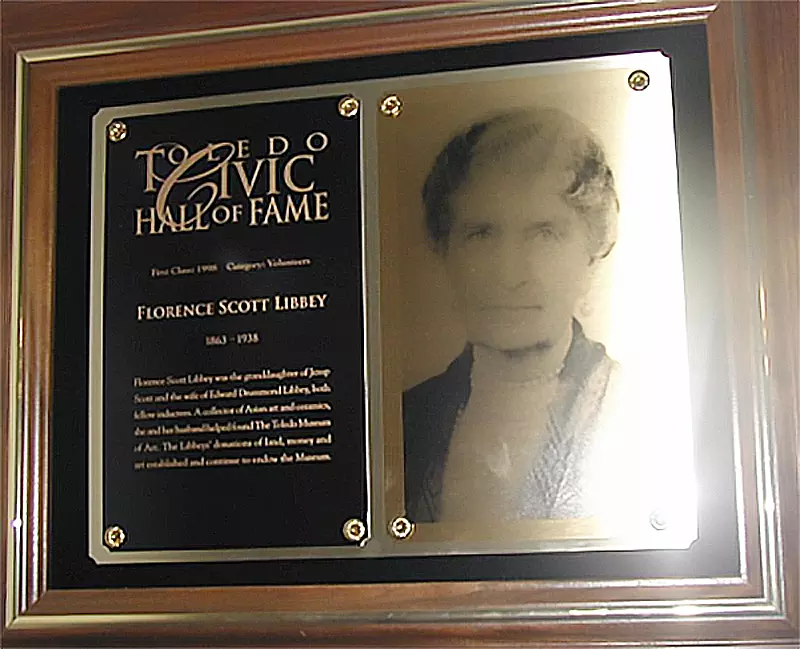 Florence Scott Libbey (1863-1938)
Florence Scott Libbey (1863-1938)
The daughter of a successful Toledo real estate dealer, Florence was 27 years old and an avid art collector when she married Edward Drummond Libbey in 1990. Their only child was born in 1895 and died when she was nine months old. Florence and Edward donated enormous financial and leadership resources to the Toledo Museum of Art (TMA), including the Scott homestead and other Monroe Street property where the museum opened in 1912. The Libbeys resisted offers to name the museum after them. Florence outlived her husband by thirteen years. After Edward's death, she served as trustee and vice president of the TMA. During the Great Depression, she financed construction of the music wings of the Museum, including the Peristyle, thus employing some 3,000 persons. She died at her summer home in Pasadena, California, at 75 years old. Her estate was left to various interests, most notably the Toledo Museum of Art and a perpetual endowment to the Scott High School Library.
Ella Nora Phillips Stewart (1891-1987), volunteer
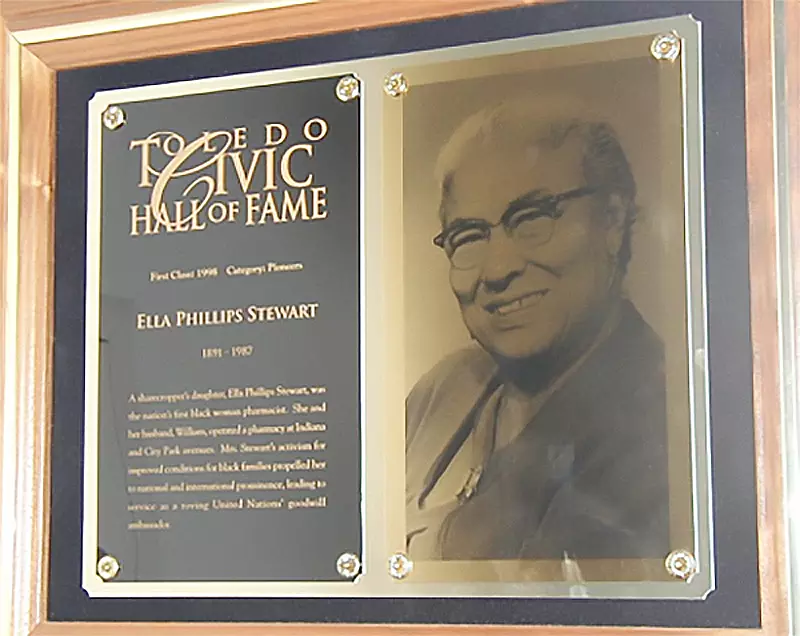 Ella Nora Phillips Stewart (1891-1987)
Ella Nora Phillips Stewart (1891-1987)
Ella Stewart was the first female African-American pharmacist and a civil rights activist at local, national and international levels. Born in West Virginia to a sharecropper, she entered Stover College in Harper's Ferry at the age of twelve. She married a classmate, Charles Meyers, and moved to Pittsburgh. After their only child died of whopping cough, she became bookkeeper at a local pharmacy. Ignoring advice from friends, she pursued her new interest by applying to the University of Pittsburgh pharmacy program, where she was accepted after a year. She graduated with high marks, passed her state exam in 1916, and became the first practicing black women pharmacist in the country. She worked around Pittsburgh, Youngstown and Detroit for the next six years. During this time she divorced, and married another pharmacist, William "Doc" Stewart. They moved to Toledo to open its first black-owned and operated drugstore in July of 1922. Together, they ran Stewart's Pharmacy, at Indiana and City Park Avenues, until it closed in 1945. The living quarters above the store housed notable black visitors to Toledo who were refused rooms at local hotels, including Marian Anderson and W.E.B. Du Bois. Dispensing medicines and advice led Stewart to a wider role in community organizations. Locally, these included the Enterprise Charity Club, the Red Cross, the League of Women Voters, the Toledo Board of Community Relations, and the YWCA. She was elected in 1944 as President of the Ohio Association of Colored Women and in 1948 as President of the National Association of Colored Women. Her involvement at the international level included membership on the executive board of UNESCO. Despite her talents and accomplishments, she faced discrimination throughout her life. In 1957, her invitation to be honored as a "Distinguished Virginian" was rescinded by the Virginia Chamber of Commerce after it realized she was African-American. In response, a ceremonial dinner was held in her honor in Toledo on May 17. In 1961, Stewart Elementary School was named after her. Stewart moved to Pelham Manor in Toledo in 1980 and died at age 94 seven years later.
The Ella P. Stewart Collection, containing papers and scrapbooks, is located in the Canaday Center at the University of Toledo Libraries. Stewart School, in Toledo, houses a museum of her documents and artifacts.
John Elstner Gunckel (1846-1915), pioneer
Born in Germantown, Ohio and educated at Oberlin College, Gunckel moved to Toledo in 1875. Though starting out in real estate, he eventually became employed as a ticket agent for the Lakeshore and Michigan Southern Railroad. He was promoted to a traveling passenger agent and ended up representing the railroad for twenty years. Working as a ticket agent, Gunckel saw firsthand the life of deprivation and wasted potential lived by the city's mostly homeless "newsboys". The boys were generally disliked for their rowdy behavior and petty crimes. Gunckel invited 101 boys to a Christmas dinner in 1892, where, with help from local newspapers and businessmen, he helped them organize the Toledo's Newsboys' Association. Association rules forbade smoking, drinking, swearing and stealing. The association sponsored educational and social activities, and the formation of a popular Newsboys Marching Band. Gunckel founded the National Newsboys Association at the St Louis World's Fair in 1904. His 1905 book, Boyville, promoted newsboys associations and gained Gunckel national recognition. Gunckel led the efforts to build the Newsboys Building, which opened on Superior Street in 1911. Gunckel died at home in 1915, eleven years to the day after the National Newsboys Association was founded. The Toledo Newsboys Association was renamed the Toledo Boys Club in 1942. The club expanded to include girls in 1982 and was renamed the Boys and Girls Clubs of Toledo. Today the club serves 6,000 members with programs aimed at disadvantaged youth.
Edward Drummond Libbey (1854-1925), pioneer
Libbey was born in Chelsea, MA and attended Boston College. In 1883, he became owner of his deceased father's glass business. His search for cheaper fuel, materials, and labor led him to Toledo, where he moved the newly named Libbey Glass Company in 1888. Aided by the inventive ideas of Michael J. Owens, the company prospered. Libbey and Owens' innovations revolutionized the glass industry. Libbey founded many offshoot companies, culminating in a series of mergers that led to the Libbey-Owens-Ford Glass Company and Toledo's status as the "Glass City". Libbey's community involvement centered on the Toledo Museum of Art, which he helped establish in 1901. Together with his wife, Florence, Libbey contributed time, leadership, collections and money. Libbey High School, named in his honor, opened in 1923. Libbey died of pneumonia in November 1925. He and Florence are buried in Woodlawn Cemetery.
Paul Block Jr. (1912-1987)
Paul Block Jr. was born in New York City and graduated from Yale University in 1933. His father owned several newspapers around the country and purchased The Blade in 1926. Although he ran his papers from his New York office, he sent Paul and his brother, William, to Toledo to learn the business firsthand. The brothers were named co-publishers of The Blade in 1941 after their father's death. Although William remained on the masthead for decades, in reality he managed the Block's other newspaper, the Pittsburgh Post-Gazette, and Paul Jr. managed The Blade. Block's influence on Toledo was enormous. During Block's 46-year tenure, The Blade was known nationally for supporting causes years ahead of popular opinion, including civil rights, newspaper guilds, environmental causes, and opposition to the Vietnam War. Block published a series of articles which helped Toledo become one of the first cities to fluoridate its public drinking water. He launched the campaign to establish the Medical College of Ohio, and was its first board chairman. His efforts to revitalize downtown included chairing the Toledo Development Committee, whose leadership produced the SeaGate Center and Government Center, the city-county-state office building. Block's positions were not universally supported, as when he opposed UAW vice president Richard Gosser's efforts to establish a pension plan for all UAW plants in the 1950's. Block's first and real love was chemistry, having earned a PhD in organic chemistry at Columbia University and spending two years at Pittsburgh's Mellon institute in the early 1940's. While managing The Blade and promoting Toledo, Block published over twenty research reports, and held a faculty position at the University of Toledo. He maintained a research lab at his River Road home, and was perhaps the world's foremost authority on thyroid gland chemicals. He once observed that he was more comfortable working with chemicals than humans, because he always knew how chemicals would react.
Henry Morse (1907-1982)
Henry Morse is the only charter member of the Toledo Civic Hall of Fame who was born in Toledo. A highly successful banker (he retired as senior vice president and secretary of Toledo Trust in 1973); he enriched Toledo's civic life with numerous activities for over 50 years. Morse graduated from Scott High School and attended the University of Toledo. He began his banking career in high school as a messenger for the former Security Bank. His first community project began also in high school, when he helped organize the Toledo Amateur Basketball Federation in 1924. Morse was key in forming the parent organization of the Lucas County Recreation Center, and made arrangements to bring the Mud Hens back to Toledo in 1965. He served on the board of the Medical College of Ohio and led fund-raising efforts for the college. Other organizations served by Morse are the Toledo-Lucas County Safety Council, Toledo Orchestra Association, Clear Water (an environmental organization begun by Paul Block, Jr.), Greater Toledo Community Chest, and St. Luke's Hospital.
Jesup W. Scott (1799-1874)
Jesup Scott was born in Connecticut and trained to be a teacher and lawyer. In the 1820's, he moved to now Erie County to tend to his father-in-law's business. While publishing a small monthly newspaper, he began another paper, the Ohio Michigan Register and Emigrants' Guide. This paper is credited with encouraging settlement of the Maumee Valley area. In 1830, he founded the first area newspaper, in Perrysburg. In 1844 he moved to Toledo and became co-publisher of The Blade, the oldest continuing business in Toledo today. In 1872, Scott donated 160 acres of land to build a "Toledo University of Arts and Trades", now the University of Toledo. Scottwood Avenue and Scott High School are named in his honor.
John D. Anderson (1922-1986)
John Anderson was the son of Harold and Margaret Anderson, who founded the Anderson Elevator Company. He grew up in Maumee and attended Michigan State University. In World War II, he was a lieutenant in the Army Air Force. He became a general partner of the Andersons in 1946 and succeeded his father as senior partner in 1968. Anderson served on numerous boards and led various civic projects. At one time he was president of the Toledo Area Chamber of Commerce, the Toledo YMCA board, the United Way, the Toledo Board of Trade, the Community Chest, and the Toledo Rotary Club. He served on the boards of the Toledo Chapter of the Red Cross, the University of Toledo, Mary Manse College, St. John's High School and the Toledo Museum of Art. He also led fund-raising efforts for several local Catholic schools, and the Toledo United Appeal.
1999 Inductees
Mildred Bayer (1908-1990), Volunteer
Mildred (Mason) Bayer was born in Weston, Ohio and received her nursing degree from St.Vincent School of Nursing in Toledo in 1932. She married Dr. Charles A. Bayer and adopted three children. In 1960, she began two medical clinics for migrant workers in Lucas County, and was instrumental in the founding of Mobile Meals of Toledo in 1967. She served as its first coordinator and later chaired the Mobile Meals Steering Committee and Task Force. She also started the Friendly Visitor Program for the aged. Following her husband's death in 1968, she spent sixteen months in Nigeria, doing medical work in a mission run by the Grey Nuns of Toledo. Upon returning to Toledo she raised a half million dollars to purchase medical supplies for the mission. She also served as president of the Little Flower Alter and Rosary Society, the Diocesan Council of Catholic Women, St. Anthony Orphanage League, and the Toledo Education Association for Aged and Chronically Ill.
Josina Lott (1898-1973), Volunteer
Josina (Jones) Lott was born in Alanson, Michigan and got her teaching degree from Ypsilanti State Normal College. She taught in various Michigan and Ohio elementary schools before coming to Toledo in 1938. She was disturbed to find the public schools turning away children with retardation and severe learning disabilities. When her son, Jack, was seven months old, she started a day school in her basement with four students. A year later, she was asked by more parents to teach their children and she expanded into Rosewood Presbyterian Church. After requesting help from the Board of Education and Chamber of Commerce, Lott Day School formed in 1945 and moved to a building at Kelsey and Heffner Streets. Lott asked the school auxiliary for money to open a sheltered workshop to employ students who had matured but were unable to find work. This was one of the first programs in the nation for vocational training of the developmentally disabled. A tax levy approved by voters in 1957 funded a merger of the Lott School with a countywide system of schools for children with cognitive disabilities. Lott remained as principal. In 1965 the Lucas County Sheltered Workshop for Retarded Persons opened. Lott Industries continue to employs over 900 persons. Lott retired at age 70 when she reached compulsory retirement age. She was also active in local, state and national organizations for the developmentally disabled. Her untiring work earned her the Toledo Times Woman of the Year Award in 1949 and the informal title "Toledo's Miracle Worker".
Samuel M. Jones (1846-1904), Pioneer
Born in Wales, young Samuel emigrated to American when three years old. His formal education was limited and he went to work at an early age. Working in the oil fields of Pennsylvania, he developed an interest in drilling technology. In 1894, he moved to Toledo and began a successful business making oil well appliances. He was distressed by the misfortune of his employees who had nothing but their labor to sell, and resolved that they would share his profits. A tin sign with the Golden Rule was erected in his shop, accompanying an eight-hour day, a week's vacation and a Christmas bonus. He encouraged his employees to unionize and marched with them in Labor Day parades. Still disturbed at class divisions, he built a playground for his workers' children and arranged for band concerts. His actions resulted in notoriety. In 1898, when Toledo Republicans sought a neutral mayoral candidate to unite factions in their party, they asked Jones to run. After he was elected, Jones surprised even his own party by insisting on a bipartisan administration and refusing to replace competent officials already in office. He created a parks system and replaced police billy clubs with white gloves. In 1899, knowing that political bosses would not re-nominate him, he demanded a direct political primary and a convention. After convention delegates were paid to nominate his opponent, Jones ran as an independent. On Election Day, Jones won by 16,773 votes to the Republican challenger's 4,266 and the Democrats' 3,125. The "Golden Rule Mayor" served into his fourth term, and was constantly embroiled in fights with the newspapers, clergy and the traction company (over trolley fares). He died from pneumonia while throngs of well-wishers kept vigil outside his house.
Brand Whitlock (1869-1934), Pioneer
Brand Whitlock is widely remembered for his political, literary and diplomatic achievements. He was born in Urbana, Ohio in 1869. He moved about Ohio with his minister father, attended high school in Toledo, and pursued his love of writing by writing for the News-Bee and The Blade. He continued working for papers in Illinois, until he turned to law and moved to Toledo in 1897, earning only enough to enable him to write. Whitlock's remorse at sending an innocent man to the workhouse spawned his sympathy towards the accused and halted his future as a prosecutor. He admired Mayor Sam Jones' intolerance for government corruption, and went to work for Jones as counsel. He also served as substitute for city judge, always showing leniency for the poor, and earning the title "The Great Suspender" along with contempt from the press. When Jones died, Whitlock declined to run for mayor, wanting instead to pursue his writing. He ran in 1905 and won his first of four mayoral terms. Opposed by the clergy and upper class, supported by the poor and emigrants, Whitlock held corruption at bay and pressed for modest reforms. He planned to find time to write after leaving office, and asked for a diplomatic appointment from then-President Woodrow Wilson, whose campaign he had aided. His appointment as minister to Belgium - a quiet, cultured, neutral country - appeared to be the respite he longed for. Ten months later, Belgium was invaded by Germany. While most diplomats fled, Whitlock remained and led relief efforts, earning him Belgium's love and gratitude. He left in 1917, as the United States prepared to enter World War I and broke ties with Germany. Whitlock spent his remaining years in Europe, finally indulging in his writing. His books earned modest praise from critics. Although Whitlock left his mark in many areas and earned much recognition in Europe, he considered his lack of greater literary success a personal failure.
Virgil Gladieux (1908-1997)
Gladieux grew up one of twelve children on his family's farm in Indiana. He moved to Toledo when he was seventeen to start a vending machine company. Aided by his wife and brother, his business grew during the Depression, providing in-house food service for companies including Jeep, Champion Spark Plug, and Libbey-Owens-Ford. In the 1950's, his company expanded to serve turnpikes, airports and universities. Gladieux was very active in civic affairs. He served on numerous boards, including hospitals, and school, arts, and community groups. As president of St.Vincent Medical Center, he brought the first life-flight helicopter to the hospital. A sports enthusiast, Gladieux built the Toledo Sports Arena with some friends and investors. He put together an NBA basketball team called the Toledo Jeeps, and brought IHL hockey to Toledo.
Monsignor Jerome E. Schmit (1910-1997)
Monsignor Schmit graduated from St. John's High School in his native Toledo. He attended the seminary in Worthington, Ohio, but was discouraged from pursing the priesthood because of a speech impediment. He found employment as a social worker during the Depression. Eventually he returned to seminary, and in 1941 was ordained as a Catholic Priest, launching his career serving Toledo's youth. Working for Catholic Charities of Toledo, Monsignor Schmit started with $27.00 and eventually organized Boy Scout and Girl Scout troops and 600 basketball teams. In 1942, he became director of the Catholic Club, which he served for nearly forty years. Pursuing greater recreational opportunities for all, he participated on the Lucas County Recreation Committee which established the Lucas County Recreation Center. Monsignor Schmit was secretary-treasurer of the Recreation Center until his death. When the Recreation Committee brought the Mud Hens to Toledo, he served as secretary-treasurer of the franchise.
John David Biggers (1888-1974)
John Biggers was a business leader and served in a variety of national governmental posts. Born in St Louis, he graduated from the University of Michigan and moved to Toledo in 1911 as secretary of the Toledo Chamber of Commerce. He joined Owens Bottle Company in 1914, and held increasingly responsible positions in production, financial, and sales departments there. In 1926 he moved to England to direct Dodge Brothers Britain Ltd, owned by Joseph and Ray Graham. He returned to New York and worked for the Grahams' other business interests, which included Libbey-Owens Glass. He came to Toledo in 1930 as president of the newly formed Libbey-Owens-Ford Corporation. He became chairman and chief executive officer in 1953 and finance committee chair in 1960. The company achieved enormous growth under Biggers' leadership. At the request of President Franklin D. Roosevelt, Biggers led the first ever-national unemployment census in 1937. He directed the U.S. Office of Production Management from 1940 to 1941 and was minister to Great Britain in charge of coordinating war production in 1941. Biggers' contributions to Toledo's civic life was extensive and included leadership in the Toledo Area Development Corporation, president of the Toledo Museum of Art, chairing the Community Chest, president of United Appeal, and trustee to several community organizations.
John F. Savage (1930-1993)
One of nine children, John Savage got his start working as a child in his parents' business - Savage Market - on North Detroit Avenue. He attended Central Catholic High School and graduated from the University of Toledo in 1952. He began selling life insurance while in college, and founded Savage & Associates with his brother, Robert, in 1957. The company is today one of the nation's largest financial firms. Savage played basketball in high school, college, and on semi-professional teams. He coached Libbey High School and Central High School teams. He co-chaired a 1973 fund-raising campaign that resulted in the basketball and concert arena at the University of Toledo now named Savage Hall. The campaign also raised money for the University's Centennial Mall. His undefeatable energy and optimism were captured in his many "Savage-isms", inspirational one-liners such as "The road to excellence is always under construction".
2000 Inductees
Eleanor Kahle (1916-1995), Volunteer
Eleanor (Konieczka) Kahle came of age during the Depression and remained an admirer of Franklin D. Roosevelt's liberalism for her entire life. She graduated from Sylvania's Burnham High School and from Davis Business College. She also took classes from Lourdes College, the University of Toledo, and Mary Manse College. She raised six sons with her husband, "Skip" Kahle, who died in 1967. From 1971 to 1979, she was a pastoral associate for the Toledo Catholic Diocese, for which she won multiple service awards. At age 63 she helped form the West Toledo Senior Center on Hillcrest Avenue, and remained executive director from 1979 to 1993. Through her appointment to a commission to unite area churchwomen, she met City Councilman Peter Ujvagi and Marcy Kaptur. She was serving as a special assistant to Ms. Kaptur on senior citizen issues in 1983, when Mr. Ujvagi asked her to run for City Council. She repeatedly declined to run until 1987, when she was elected. In her three terms on City Council, she was a tireless advocate for the elderly and poor. She also served as vice-mayor for two years. She was active in Toledo's Sister Cities program, traveling to Szeged, Hungary, three times. She died after a brief illness and was often remembered by the sign in her Council office pronouncing "It is not enough to add new years to life. One must add new life to years".
Elizabeth (Liz) Pierson (1931-1998), Volunteer
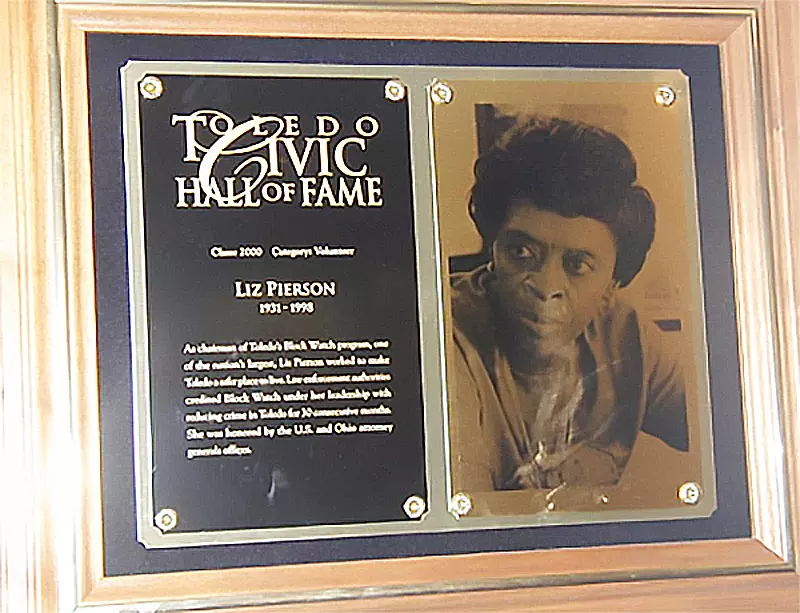 Elizabeth (Liz) Pierson (1931-1998)
Elizabeth (Liz) Pierson (1931-1998)
Born in Pittsburgh, Liz and her husband, Nathanial, came to Toledo in 1969 for her husband's construction job. She worked as an adult education leader until she slipped on some icy steps and broke her knee. Forced into early retirement, Pierson became more aware of the neighborhood surrounding her Palmwood Avenue house, including the alleged crack house down the street. She became a leader in Block Watch programs, putting in 60 to 80 hours per week and serving as president of the Block Watch Advisory Board. At her death, Toledo's Block Watch program was one of the country's largest, with more than 100,000 members and 100 groups in Toledo. Mayor Carty Finkbeiner credited the program with Toledo's 30-month decline in crime. She was personally thanked for her work by Attorney-General Janet Reno in 1997 in Washington D.C., during a three-day trip sponsored by The Blade. She was also awarded numerous awards. She is buried in Woodlawn Cemetery along with several other Toledo Civic Hall of Fame awardees.
Sylvanus Pierre Jermain (1859-1935), Pioneer
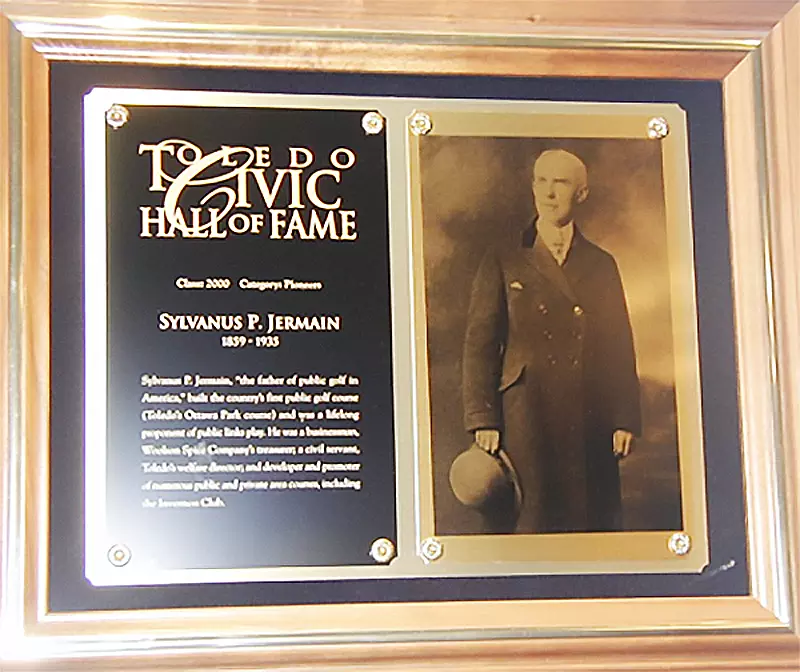 Sylvanus Pierre Jermain (1859-1935)
Sylvanus Pierre Jermain (1859-1935)
"The Father of Public Golf in Toledo" was born in Adrian, Michigan and moved to Toledo with his family in 1871. His mother, a widow raising six children, became head librarian of the Toledo Public Library, and was active in civic affairs. Jermain's interest in public parks sprang from his struggle with asthma and his enthusiasm for the parks he saw while visiting New York City and Chicago. He watched impatiently in the 1880's as Toledo voters repeatedly voted against city park funding. He began installing at his own expense, benches and a bike path in a little stretch along Summit Street known as Riverside Park. Simultaneously, he began printing pamphlets and speaking publicly about the need to fund parks. As a successful businessman (he was treasurer of the Woolson Spice Company, and one of the founders of the Manufacturers' Association), he had the business community's ear. By 1891 he had the necessary 3,000 signatures to hold a bond issue for parks on the November ballet. The passage of this issue and the newly formed Board of Park Commissioners provided the funding and leadership resulting in Walbridge and Ottawa Parks. An avid golfer, Jermain lobbied for public courses, and in 1898 the first public golf course was established at Ottawa Park. Jermain Park was named in his honor in 1915.
Michael Owens (1859-1923), Pioneer
Michael was born in Mason County, West Virginia. At age ten he went to work in a glass factory to help support his large family and escape work in the coal mines. By age fifteen, he was a skilled glassblower, working twelve to fourteen hours a day. In his late twenties, he led a strike that shut down Edward D. Libbey's Cambridge, Massachusetts glass plant. When Libbey moved his operation to Toledo, where he thought business conditions were better, Owens followed. When Owens threatened to quit because of poor work habits at the plant, Libbey offered him the position of plant superintendent. Owens fired the entire crew and rehired those men he wanted. Production problems gradually ceased. Owens also oversaw a plant in Findlay and the Libbey exhibit at the 1893 Columbian Exhibition in Chicago. After Owens designed an automatic machine for blowing drinking glasses, Libbey formed the Toledo Glass Company in 1895. With Libbey's support, Owens continued to design numerous glass making tools that greatly enhanced production. In 1903 the Owens Bottle Machine Company was formed with Owens as general manager and Libbey as president. As the company became the world's largest producer of glass bottles, Owens became interested in Irving Colburn's attempts to manufacture sheet glass. Libbey bought the patent rights to Colburn's process and brought Colburn on board. Owens and Colburn tweaked the first flat-drawn sheet glass process into commercial use and formed the Libbey-Owens Sheet Glass Company in 1916. For the next six years Owens served as vice-president of the Owens-Bottle Company and the Libbey-Owens Sheet Glass Company. On December 27, 1923, he asked to be excused momentarily from a board meeting, fainted, and died fifteen minutes later. Owens Community College is named in his honor.
Harold Boeschenstein (1896-1972)
Born in Edwardsville, Illinois, 'Beck" went to the University of Illinois and served in the Army during World War I. He worked in various departments of the Illinois Glass Company beginning in 1921. When Owens Bottle Company and Illinois Glass Company merged to form the Owens-Illinois Glass Company in 1929, he came on as a vice president. He was named director of the new Owens-Corning Fiberglas Corporation in 1938 when it was formed and remained president for thirty years. Known as "Mr. Fiberglas", Boeschenstein oversaw tremendous growth in Fiberglas use. Annual sales of Owens-Corning Fiberglas grew from $3 million in 1939 to $274 million in 1963 under Boeschenstein's leadership. He earned the President's Medal for Merit in 1947 for serving as vice chairman of operations for the War Production Board from 1942-1945, allocating resource materials to war industries. He was president of the Toledo Museum of Art from 1967 to his death, and donated the two-story glass galleries to the museum. He served on numerous nonprofit boards and chaired fundraising campaigns for the Toledo Community Chest, local hospitals, and the Toledo Red Cross.
Jules D. Lippmann (1899-1974)
Born in the Bronx, Lippmann quit high school to work at Textileather Corporation. He rose from office boy to president and general manager in 1943. Lippmann moved to Toledo with Textileather in 1930. When General Tire & Rubber acquired Textileather in 1954, Lippmann continued his career managing the Textileather division and then the chemical plastics division. He retired in 1964, but continued consulting. He served on numerous boards including the Greater Toledo Community Chest, the University of Toledo, and Toledo Orchestra Association. He spearheaded the fund drive that created the Jewish Community Center. He was also honored by labor leaders for his achievements in labor-management relations.
Grove Hiram Patterson (1881-1956)
After growing up in Elyria, Ohio, and graduating from Oberlin College in 1905, Patterson worked for the Oberlin Tribune, Times-Herald of Lorain and the Cleveland Plain Dealer. He moved to Toledo in 1909 to work for the Toledo Times. After being fired from the Times, he became news editor of The Blade in 1910, and rose to managing editor in 1917. Known as "Mr. Blade" and "Mr. Toledo", he traveled extensively as a speaker, relaying his thoughts in his popular Blade column "The Way of the World". He resisted attempts from larger papers to lure him away, preferring to stay instead in his beloved Toledo. He served on numerous boards, and worked for the local and national YMCA. Grove Patterson School was named for him in 1951.
Melvin Pelfrey (1930-1989)
Raised in a small town along Lake Erie, Melvin longed to escape the boredom of school and small town life. He forged a birth certificate and took a job shoveling coal in a Great Lakes steamer, six weeks shy of his high school graduation. Married in 1951, he saw his wife, Shirley, once or twice during the nine month shipping season. Working his way up the ranks, he became aware of labor issues in the shipping industry. In 1956, Pelfrey took charge of a faltering strike called by the Marine Engineers Beneficial Association (MEBA), pitting the crews of 61 ships against owner U.S. Steel. Making eleventh hour phone calls to ship crews at six Great Lakes ports to tell them (falsely) that critical Duluth workers had struck, he prompted a successful strike. When MEBA was elected as the representing union, Pelfrey was elected head of MEBA's district two office. He became national vice president of the union in 1957. From its headquarters on One Maritime Plaza on Water Street, MEBA represented some 40,000 people when Pelfrey died suddenly from a heart attack in 1989. He is remembered for his knowledge of Great Lakes shipping, his fairness, and his commitment to trade workers.
2001 Inductees
Emory Leverette (1915-1996), Volunteer
Leverette graduated from Alabama State College in Montgomery and received his master's degree from the University of Michigan. At age 29, he became the Toledo Public Schools' first African American administrator, serving as assistant principal at Gunckel Elementary School. At that time, African-American teachers were only allowed at that school. Toledo's peaceful, voluntary school desegregation process is due largely to Leverette. Leverette became principal of Gunckel in 1955, and administrative assistant to the district superintendent in 1967. During the 1970's, the district launched a voluntary desegregation plan, avoiding any court-ordered desegregation. Leverette Junior High was named in his honor in 1980.
Cordelia Martin (1915-1999), Volunteer
Cordelia Martin raised twelve children with her husband, Walter, but considered all the neighborhood children her own. As a volunteer with the Model Cities Neighborhood Residents Association, she was disturbed by the lack of available heath care for the disadvantaged. After years of effort, the Cordelia Martin Health Care Center opened in 1971 on Nebraska Avenue. In 1997, the Center served about 20,000 elderly, low-income, and non-insured people. Martin received a degree from the University of Toledo and worked for eighteen years as a social worker for Planned Parenthood. She was active in the NAACP and the Frederick Douglas Community Center.
Edward Ford (1843-1920), Pioneer
Ford was born in Greenville, Indiana. His father, John Baptiste, owned the first company to manufacture plate glass in the United States, using machinery imported from England. Edward followed him into the business, working for him in Pennsylvania and establishing plate glass companies in Columbus, Ohio, and Indiana before moving to Toledo in 1898. The wide, empty plain along the Maumee River just east of Toledo beckoned and he opened the Ford Plate Glass Company on 173 acres there in 1898. It was the largest factory in the country under one roof. The town of Rossford sprang up alongside it (its name coming from Ford and wife Carrie's maiden name). The company merged later to become Libbey-Owens-Ford and is now part of Pilkington. Ford died at age 77 at his home on Collingwood Avenue and is buried in Woodlawn Cemetery.
Frank Leroy Skeldon (1884-1948), Pioneer
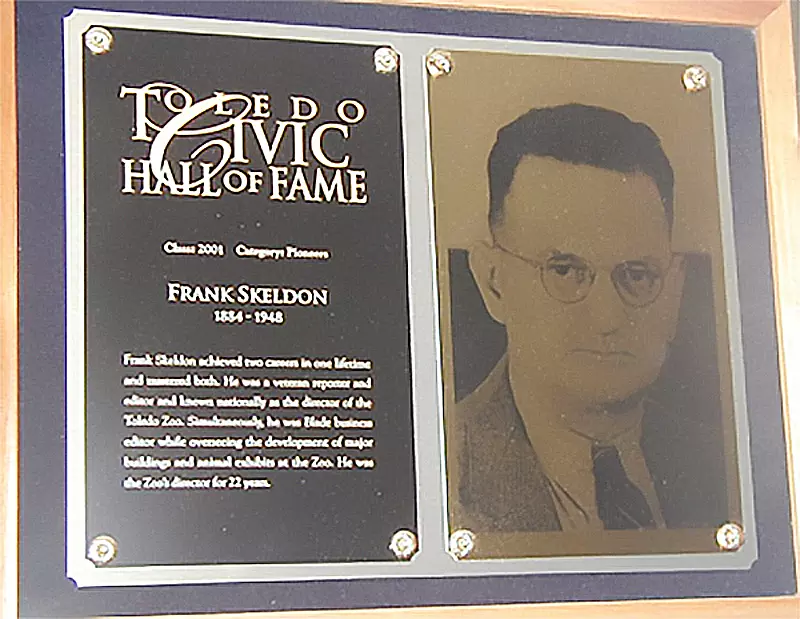 Frank Leroy Skeldon (1884-1948)
Frank Leroy Skeldon (1884-1948)
Born in North Toledo, Frank followed his father's footsteps and became a tugboat fireman in his teens. At seventeen, he attempted boxing, was promptly knocked out, and found employment as an office boy at the Toledo News-Bee. He began his reporting career shortly after, and joined The Blade in 1902. He scooped the Titanic story by using his marine skills to meet the tug loaded with survivors offshore, a full hour ahead of other reporters. Throughout his 47 years as a newspaperman, he always enjoyed reporting best, eschewing administrative duties whenever possible. In 1905 he was assigned to write a story about animals that had escaped from the Toledo Zoo. As a South Side resident, he had followed the new zoo's progress. He joined the zoological society, became secretary of the society and later director of the zoo in 1926. He remained director until his death in 1948. Skeldon had abundant plans for expanding the zoo, and in the 1930's, when New Deal programs sought employment projects in Toledo, Skeldon was waiting. The zoo amphitheater, reptile house, aviary, aquarium and tunnel under Anthony Wayne Trail were built at this time, putting 1,300 laborers to work. Skeldon was also skilled at coaxing labor unions to help supply needed materials for zoo projects. Many zoo buildings were made out of reclaimed materials. Carvings were sculpted out of blocks from old Erie Canal locks. Despite Skeldon's modesty, he was awarded numerous honors and accolades by the press. When he died at age 64 of cancer he was widely praised.
Charles A. Dana (1881-1975)
Dana grew up in New York City, where he earned his law degree at Columbia University. He practiced law for ten years and served three terms on the New York State Legislature. In 1914 he purchased control of Spicer Universal Joint Manufacturing Inc., an innovative but struggling New Jersey company. Dana oversaw management of the firm, which grew under his guidance and gradually demanded most of his time. In 1929 the company was moved to Toledo to be near Detroit's automotive industry. The company was renamed the Dana Corporation in 1946. Dana retired as chairman of the board in 1966, devoting most of his time to the Charles A. Dana Foundation, a private, philanthropic foundation funding projects in science, health and education. One of the Foundation's hallmark "challenge gifts" (requiring recipients to raise one-third or one-half the amount granted) resulted in the University of Toledo's engineering science building. Dana was known for his frugality and concern for his employees.
Marvin Kobacker (1911-1993)
Kobacker's father, a Lithuanian immigrant, opened his first store in Pennsylvania when he was eighteen years old. The Kobacker's chain grew to include thirteen stores in Ohio and New York. In 1925, he purchased Tiedtke's Department Store in downtown Toledo. His son's work in various stores was interrupted by World War II. Marvin returned from the Navy to manage Tiedtke's. He became vice-president in 1946 and president in 1952. Kobacker was an enthusiastic booster of downtown Toledo, and worked with business leaders to keep the downtown area vibrant. His influence on the arts in Toledo was profound. He served as president of the Toledo Museum of Art and the Toledo Symphony. He made substantial donations to the art museum and built the large performance hall at Bowling Green State University named after him. He actively worked for county mental health boards and served as president of the Lucas County Board of Mental Health and Mental Retardation. He contributed $1.2 million to the Kobacker Center at the Medical College of Ohio, a residential treatment center for youth.
James Nicholson (1905-1983)
Trained as a lawyer, Nicholson never practiced law. His young adulthood was dedicated to coaching football and basketball at his alma mater, Sandusky High School. He joined the University of Toledo in 1930 as its first full-time football coach. When he retired from the University in the mid-1930's and his assistant coach was not hired to replace him, the two men went into the concrete business together. He continued to support athletic programs at the University and throughout Toledo. He also headed three public school levy campaigns.
Edward "Ned" Skeldon (1924-1988)
The son of Frank Skeldon, "Ned", grew up in South Toledo and played football for Central Catholic High School and the University of Toledo. He joined the Navy in World War II, and worked for former Toledo Mayor Michael DiSalle in Washington D.C., before returning to Toledo to pursue local politics. He served as vice-mayor of Toledo and four terms as president of the Lucas County Board of Commissioners, from 1958 to 1966. For thirteen years, he was head of Clear Water Inc., an organization dedicated to cleaning the Maumee River. He was also vice chair of the Ohio Water Development Authority, a state-wide environmental agency. As a member of the Lucas County Recreation Inc., he was instrumental in bringing the Mud Hens back to Toledo in 1965. The Mud Hens Stadium was renamed in his honor in June of1988, three months before his death.
2002 Inductees
Harold Anderson (1894-1968)
Anderson was born in Saint Louis, but moved to Toledo in 1908 and graduated from Toledo Central High School. He attended the University of Wisconsin for three years before enlisting as a pilot in World War I. Following the war, he worked for the National Milling Company and succeeded his father as general manager in 1927. In 1936 he formed the Anderson Elevator Company with his wife, father, and others, on their family farm in Maumee. The Toledo area's prime shipping location supported the company's expansion, which included the elevators, a warehouse market, a manufacturing division, a feed division, and Anderson Cob Mills, Inc. Anderson's belief that people of means should invest in their community was evidenced by his numerous civic activities. He was on the board of St. Vincent's Hospital, the Greater Toledo Community Chest, and the Council of Social Agencies. He was a particularly strong supporter of the YMCA, having served as president and participating in numerous fund-raising campaigns.
Phyllis (Fox) Driggs (1938-1992), Volunteer
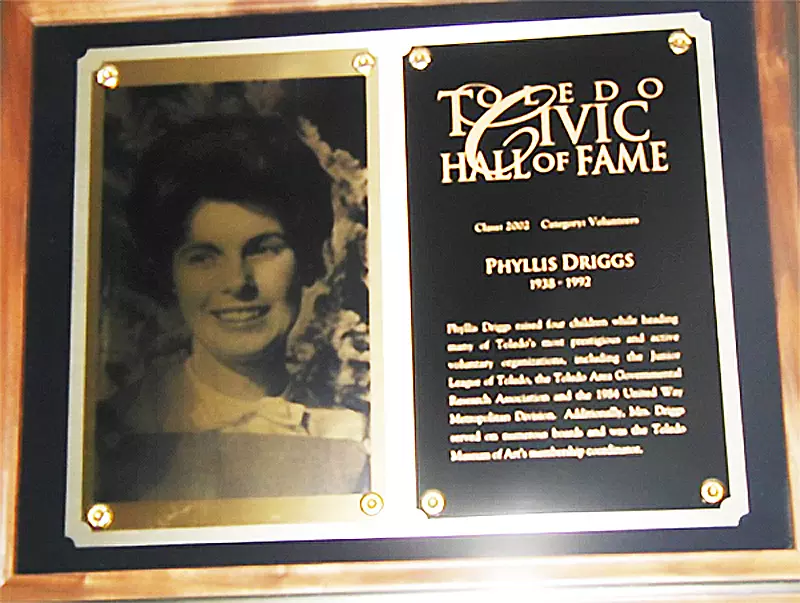 Phyllis (Fox) Driggs (1938-1992)
Phyllis (Fox) Driggs (1938-1992)
Driggs was born in Adrian, Michigan and graduated from Adrian College. She taught speech in Toledo high schools and raised four children with her husband, Howard. She worked as coordinator of membership services for the Toledo Museum of Art from 1986 to 1992. Her tireless volunteer spirit aided several area civic organizations. She was 1984 United Way Metropolitan Division chairperson, and served as president of the Junior League of Toledo. She was on the board of WGTE-TV and chaired its auction. She also served on the boards of Adrian College, the Crosby Gardens, and Riverside Hospital. Her husband recalled that "She loved Toledo and she wanted to make it a better place for everybody".
Dr. Morton Goldberg (1901-1999)
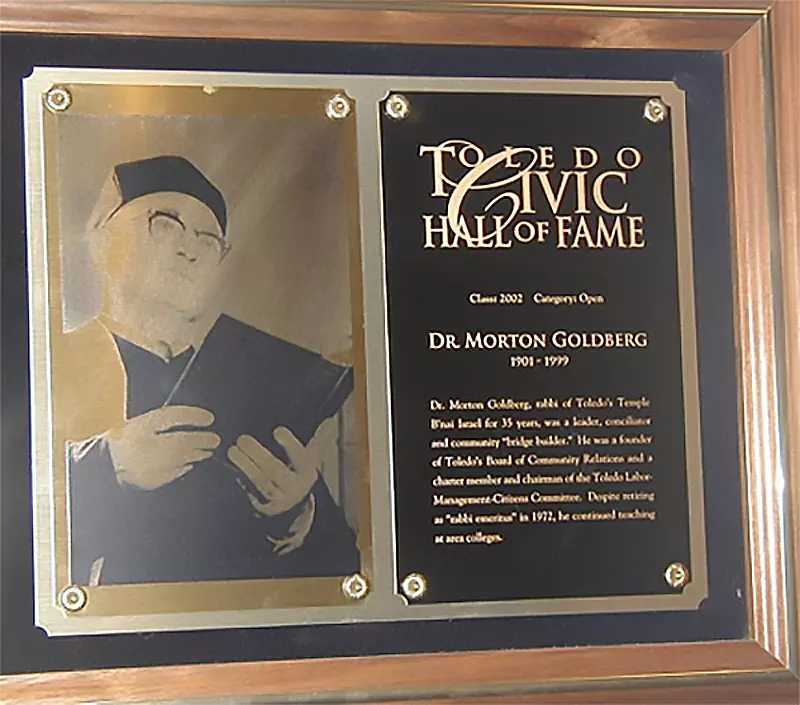 Dr. Morton Goldberg (1901-1999)
Dr. Morton Goldberg (1901-1999)
Dr. Goldberg was Rabbi for 36 years of Temple B'nai Israel, Toledo's Conservative Synagogue. He was born in Poland and came to Pittsburgh as a boy with his parents. Educated at Jewish Theological Seminary in New York, Brown University, and Webster University in Delaware, he first served in Fall River, MA, where he met his wife, Doris. Their 68-year marriage enriched their respective careers as rabbi and writer. Rabbi Goldberg believed that to serve his own congregation, he needed to serve his wider community. Upon coming to Temple B' nai Israel in 1937, he soon became active in community affairs. He was one of the "Three Musketeers", including 1998 inductee Ella Stewart, and Director of Catholic Charities Msgr. Michael Doyle, who met with business leaders in the mid-1930's to discourage discrimination. Rabbi Goldberg is largely credited with founding the Board of Community Relations in 1946, which continues to investigate and mediate civil rights issues today. He was also a charter member of the Toledo Labor-Management Citizens Committee, and only dined at unionized restaurants. Rabbi Goldberg also served as president of the Toledo Board of Education, and on numerous other boards.
David Ross Locke (1833-1888)
A native of New York State, Locke was apprenticed to the Courtland Democrat at age ten, where he learned the newspaper business. He worked for papers in Pittsburgh and Ohio, until he became owner and editor of the Findley Jeffersonian. He developed a deep hatred of slavery from his abolitionist father and his own observations. In 1865, accompanied by his wife and three sons, he arrived by covered wagon in Toledo to take on his new job as editor of The Toledo Blade. Beginning in 1861, Locke published letters in his papers under the name Petroleum V. Nasby, using sarcasm and wit to support his favorite causes: the Republican Party, abolition, and the Union. Locke's nearly daily Nasby letters earned him national recognition and led to frequent speaking tours. His son, Robinson, accompanied him on some of these trips and succeeded him as Blade editor. He befriended his contemporary humorist, Mark Twain, and was a favorite writer of Abraham Lincoln. Presidents Lincoln and Grant failed to persuade Locke to take diplomatic appointments in their administrations. Despite his decline from tuberculosis, his support for the temperance movement led him to become a Toledo alderman in 1886, a position he held when he died. He was honored by The Society of Professional Journalists in 1978 as one of America's historic individuals in journalism.
2003 Inductees
Peter Navarre (1785-1874), Pioneer
Born in Detroit, French-speaking Navarre was one of the earliest settlers of the Maumee Valley. In 1807 he built a cabin with his five brothers on the east side of the Maumee River near Lake Erie. A French settlement soon sprang up around it. Navarre traded extensively with the Pottawatomie and learned the dialects of several Native American tribes. When the War of 1812 broke out, pitting the young United States against Britain, Navarre became a scout for American General William Hull. He survived the 1813 River Raison Massacre, where hundreds of Americans were killed and captured by the British. He then joined General William Harrison (later President Harrison) stationed at Fort Meigs. His legendary trek to Put-in-Bay with news for Commodore Perry of the British advance is credited with winning the Battle of Put-in-Bay. By the time he died at age 89, he was legendary for his bravery and skill. A portrait of Navarre by the Toledo painter, William Machen, hangs in the local history room of the Toledo Lucas County Public Library. His log cabin was relocated to the Toledo Botanical Gardens where it remains today.
George W. Pearson (1870-1955), Volunteer
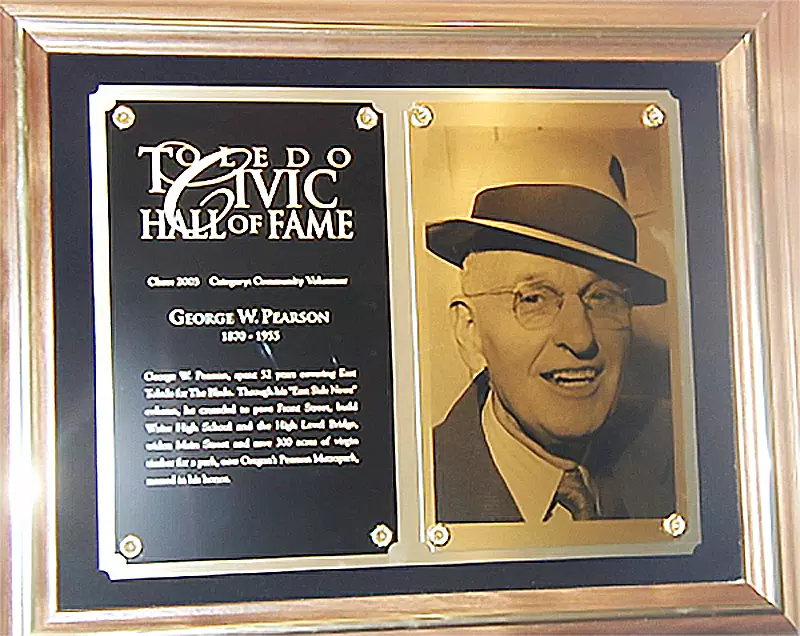 George W. Pearson (1870-1955), Volunteer
George W. Pearson (1870-1955), Volunteer
Born in Covington, Ohio, Pearson worked as a Blade correspondent as a high school senior in Van Wert, Ohio. He attended Ohio Wesleyan University. After pursuing teaching and railroad jobs, he returned to the newspaper work he loved. He came to Toledo in 1893 and was soon working for The Blade. Seven years later, he was "banished" to covering East Toledo as retribution for his loyalty to Mayor Sam Jones. Two years later, he moved from his West Side home to St. Louis Street, and remained a committed "East Sider" for life. From 1897 to 1947, Pearson wrote an almost daily column for the East Side, covering all manners of issues from sports to society. He also championed East Side causes. He demanded that Front Street be paved and Main Street widened. He lobbied for Waite High School and the High Level Bridge. He helped numerous civic groups, including the Boy Scouts and the YMCA. His chief concern was parklands and he urged civic leaders and businessmen to preserve remains of the Great Black Swamp. Pearson Metropark was named in his honor when founded in 1934. Pearson is remembered fondly for his dedication as a "one-man chamber of commerce".
McClinton Nunn (1906-1968)
Nunn was born in Colt, Arkansas, and attended Temple, Fisk, and Wayne State Universities. He worked as an educational administrator and served in the army in 1943 and 1944. Following the war, he worked for various public housing agencies until coming to Toledo in 1950 as executive director of the Toledo Metropolitan Housing Authority. He was the first African American in the nation to lead a major public housing authority. Nunn oversaw the desegregation of Toledo's public housing, and established the first housing project specifically designed for the elderly. He also built the first homes for large families on scattered sites, helping remove the stigma of public housing. He was nationally recognized for his expertise and the recipient of numerous awards.
Tom Hart (1936-1998)
A Toledo native, Hart graduated from Central Catholic High School and the University of Toledo, where he played football. He was an Army Captain in World War II. In 1965, he founded Hart Associates, a marketing and communications firm, in his basement. The firm created many successful public interest advertising campaigns, including the "Toledo Loves Jeep" campaign which helped persuade Daimler-Chrysler to keep Jeep in Toledo in the 1990's. Hart was very active in civic affairs. He served on the boards of the Red Cross, St. Charles Hospital and the Press Club of Toledo. He led several fund-raising efforts for area causes and was Northwest Ohio marketing coordinator for the Partnership for a Drug-Free Ohio. Hart is remembered for his outspoken civic pride.
2004 Inductees
Robert Pew (1862-1925), Pioneer
Robert Pew grew up in Pennsylvania where his uncle, Joseph Pew, started his oil business in the 1870's. In 1886, Joseph sent Robert to Ohio to investigate that state's oil potential. Acting on Robert's enthusiastic report, Joseph acquired two oil drilling leases in Findley Township . Robert oversaw the operation, which shipped crude oil in wooden barrels on mule wagons from Findley to Toledo for refining. The business grew and in 1890, Joseph Pew and his partner, Edward Emerson, incorporated the Sun Oil Company. Robert remained in charge of Ohio operations. He was vice president of Sun and director or Toledo operations when he died in Perrysburg at age 63. Robert was also a director of the Toledo Trust Co., president of United Malleable Iron Company, and vice president of Toledo Traveler's Life Insurance Company.
Sara Kaufman (1868-1941), Volunteer
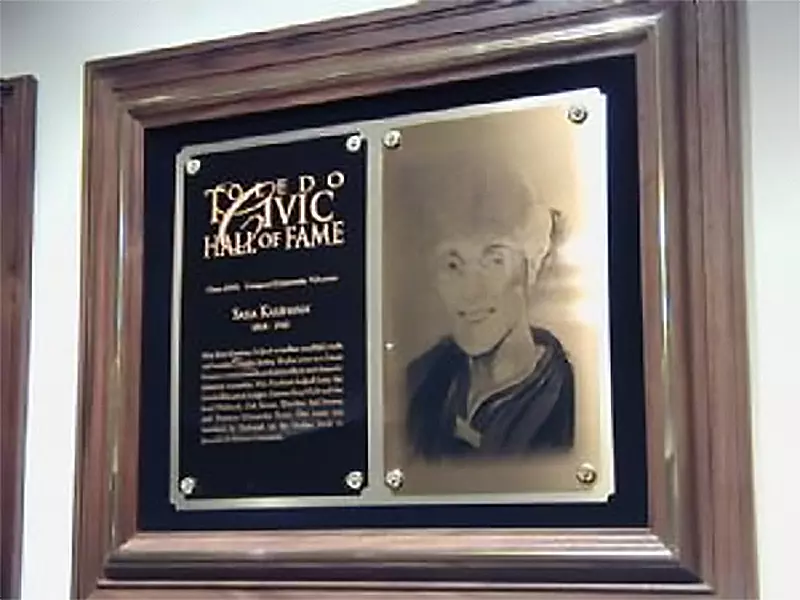 Sara Kaufman (1868-1941)
Sara Kaufman (1868-1941)
An Ohio native, Sara grew up in Bryon, where she attended public school. She later moved with her family to Toledo, where she worked at Lamson's department store downtown. In 1905 she began volunteering at a settlement house run by the Toledo Council of Jewish Women. She was hired by the Lucas County Probate Court as a juvenile court probation officer in 1909. She held this position for 31 years, practicing her belief that "there are no bad children; only misunderstood children". She helped organize the Banner Boys Club for Jewish boys in 1907. She was a founding member of the local Travelers' Aid Society and on the board of the Florence Crittenton Home for unwed mothers. She was also vice president of the Toledo Girl Scouts and an early vocal supporter of the NAACP.
Edwin Dodd (1919-2001)
Dodd was born in West Virginia, the oldest of three children, and grew up in Morgantown, Ithaca, and Columbus, Ohio . He attended Ohio State University and Harvard University 's Business School . During World War II, he served as an information and education officer for General MacArthur's staff. In 1946 he became a sales trainee for Owens-Illinois, but was soon transferred to the public relations department. He became public relations director four years later. By 1954, he was a production manager for the Libbey Glass division. In 1968 he became president and chief operating officer. He became chief executive officer in 1972 and chairman and CEO in 1976. He retired in 1984. Dodd played a major role in efforts to revitalize downtown Toledo during the 1970's. When Owens-Illinois outgrew its headquarters in 1981, it built a new 32-story headquarters downtown. Dodd was named to national posts by four U.S. Presidents. In 1983, he served on the President's Commission on Industrial Competitiveness under President Reagan. President Carter appointed him to the President's National Commission on Air Quality. He served on President Ford's Executive Finance Committee in 1976, and was appointed by President Nixon to the National Industrial Pollution Control Council. Locally, Dodd was active in many civic causes. He served as president to the Toledo Museum of Art, the Toledo Board of Education, and the Toledo-Lucas County Port Authority. He was a founding member of the Northwest Ohio Chapter of the Public Relations Committee of America in 1951.
Duane Stranahan, Senior (1903-1998)
Duane Stranahan was born in Massachusetts, the only son of Frank Stranahan, who formed the Champion Spark Plug Company with his brother Robert in 1908. His family moved to Toledo in 1910 when Champion relocated nearer Detroit 's budding automotive industry. Stranahan graduated from Scott High School and received an English Literature degree from Harvard University . He worked in several departments of Champion in the 1930's. He directed aviation research and production, and developed a ceramic spark plug used extensively in World War II aircraft. Following the war, he guided Champion's move into the general aviation industry. Stranahan retired in 1973 after 46 years with Champion. Stranahan obtained his pilot's license in 1930 and was an avid pilot. He was a member of the Toledo Aviation Commission, which opened Toledo Metropolitan Airport to commercial use, and also served as chair of the development committee for Toledo Express Airport . With his wife, Virginia, he started a family foundation in 1956 called the Needmor Fund. This contributed $3.2 million to local community efforts before it moved to Colorado in 1982. He also managed the larger Stranahan Foundation from the 1960's to the 1980's with his cousin, Robert. The Stranahan Foundation donated $2 million in 1966 for the Community Services Building, and $2 million to the University of Toledo in 1981 for the business administration building. With the family of W.W. Knight, he donated 42 acres in Perrysburg for Woodlands Park in 1973. In addition, he chaired the Toledo War Chest, the Greater Toledo Community Chest's budget committee, and the University of Toledo 's research foundation. He was a trustee of Toledo Hospital and chairman of the hospital's Institute of Medical Research.


